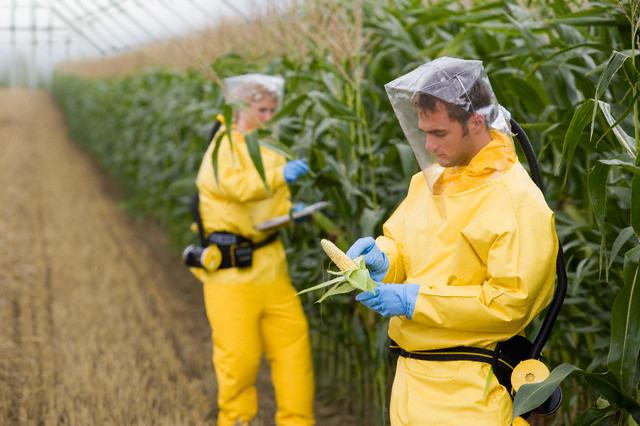Addiction #06 … Junk Food (part 4 of 4 — GMO’s) 05/23/12
LICKING THE RAZOR’S EDGE
Addiction #06 – the challenge of JUNK FOOD (Part 4 of 4 – GMO’s)
One of the more disturbing trends of the last few years has been not only the production and distribution of dangerous, addictive foods, but the engineering of such substances as well. For those of you who are not yet aware, these “GMO’s” (which stands for “genetically modified organisms”) are plants or animals created using experimental gene splicing technology, which merges the DNA from different species, creating unstable combinations of plant, animal, bacterial and viral genes that cannot occur in nature. Virtually all commercial GMO’s are engineered to withstand the direct application of herbicides and/or to produce an internal insecticide. Despite biotech industry promises, none of the GMO traits currently on the market offer increased yield, drought tolerance, enhanced nutrition, or any other benefit to consumers.
If these foods weren’t so prevalent, this wouldn’t be a big deal, and yet it has been consistently estimated that GMO’s are found in as much as 80% of the conventional processed foods in American grocery stores … 80%!
And yet this information still begs some questions:
Why are GMO’s bad for us?
*GMO studies of animals show that genetically modified foods cause organ damage, gastrointestinal and immune system disorders, accelerated aging, and infertility.
*The toxic insecticide produced by GM corn (which is very common in foods produced in the States) was found in the blood of pregnant women and their unborn fetuses.
*A multitude of health problems intensified in the United States after GMO’s were introduced in 1996. The percentage of Americans with three or more chronic illnesses jumped from 7% to 13% in just 9 years; food allergies skyrocketed, and disorders such as autism, reproductive disorders, digestive problems, and others are still on the rise.
Why are GMO’s bad for the environment?
*Most GMO crops are engineered to be “herbicide tolerant”. Monsanto, the company responsible for the GMO contamination of almost all the soybeans produced in the U.S., sells Roundup Ready crops designed to survive applications of their Roundup herbicide.
Overuse of Roundup results in “superweeds” that are resistant to the herbicide. This is causing farmers to use even more toxic herbicides every year. Not only does this create environmental harm, GM foods contain higher residues of toxic herbicides. Roundup herbicide has been shown to cause birth defects in amphibians, embryonic deaths and endocrine disruptions, and organ damage in animals even at very low doses, and has been linked with sterility, hormone disruption, birth defects, and cancer in humans.
*GM crops and their associated herbicides harm birds, insects, amphibians, marine ecosystems, and soil organisms. They reduce bio-diversity, pollute water resources, and are unsustainable.
*GMO crops are eliminating habitat for monarch butterflies, whose populations are down 50% in the US.
*GMO canola has been found growing wild in North Dakota and California, passing on its herbicide tolerant genes on to weeds and other native plants.
The GMO EPIDEMIC – a SOLUTION …
“In order to change we must be sick and tired of being sick and tired.” ~ unknown
If even a small percentage of us start rejecting brands that contain GMO ingredients, GMO’s will become a marketing liability and food companies will stop using them. In Europe, for example, the tipping point was achieved in 1999, just after a high profile GMO safety scandal hit the papers and alerted European citizens to the dangers.
Fortunately, there are healthy shopping alternatives showing up all over the country – there is a “Good Food Revolution” underway in the United States, and you are allowed to participate.
How? You might ask – It’s pretty simple, really … Here are a few tips that are easy to implement:
TIP #01 … BECOME INFORMED. Information on GMO contamination and other carcinogens in processed foods are easy to find these days. Make a list of all the foods you regularly buy at your favorite grocery store and the look them up. Chances are they are laced with ingredients that are slowly but surely damaging your health and the health of those you Love. gently refuse to but these items anymore …
TIP #02 … READ THE LABELS. You might not be the most informed person on the planet, and you might very well not have the time to become knowledgeable on which ingredients are killing you and which aren’t, and yet you can take a few minutes whenever you shop and read the ingredient lists of the items you wish to purchase. Essentially, follow the simple rule: IF YOU CAN’T PRONOUNCE IT, DON’T EAT IT.
“Don’t eat anything your great-great grandmother wouldn’t recognize as food. There are a great many food-like items in the supermarket your ancestors wouldn’t recognize as food … Stay away from these.” ~ Michael Pollan
TIP #03 … BUY LOCAL. This one is verrrrry important. Not only does doing so further the cause of Healthy Food, it cuts back on the immense damage done to our planet by shipping our foodstuffs over vast distances to supermarkets. If you do not have the space or the inclination to grow your own food (the best alternative), then at least choose to KNOW YOUR GROWERS. There is something very Right about personally knowing the women & men who produce & harvest your food. Find some way to do this.
TIP #04 … BUY ORGANIC. Organic tomatoes have almost two thousand milli-equivalents of iron, while conventional tomatoes have LESS THAN ONE! Organic spinach has almost 300 milli-equivalents of calcium, whole conventional spinach has less than 50. Organic lettuce has over 175 milli-equivalents of potassium, while conventional lettuce as less than 54. These vitamin and mineral discrepancies flow across the board for ALL organic vegetables when compared to their conventional counterparts.
This might be a bit more expensive for you, and I know that times are tough for many of you out there, and yet buying organic is TOTALLY WORTH IT. After all, what good is it to save money of food that is not really food?
As one very wise man once said — “Either you will pay for good food today, or you will pay the doctor tomorrow.”
In essence, my Friends, how you buy your food boils down to one founding principle: SHOP LIKE YOU CARE!
Shop like you Care about the planet,
Shop like you Care about animals,
Shop like you Care about your Loved Ones, and
Shop like you Care about yourself.
“The doctor of the future will no longer treat the human frame with drugs, but rather will cure and prevent disease with nutrition.” ~Thomas Edison





 ;
;